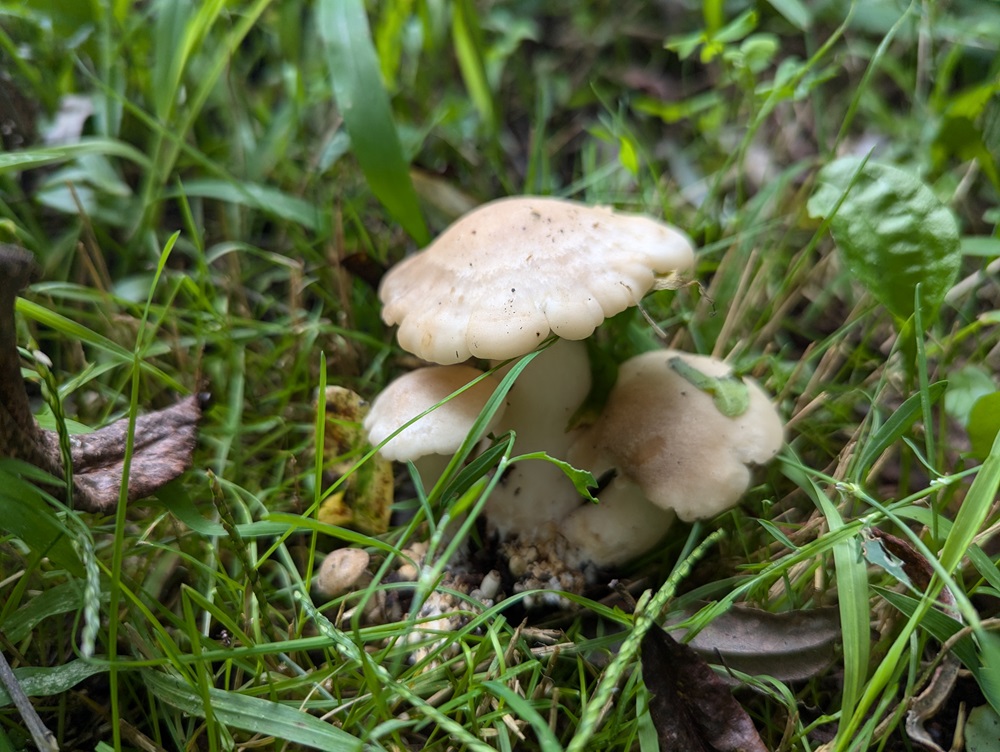The Spotlight is pulled from our weekly mushroom e-mail that features spotlight articles, interesting mushroom news, events and activities. It’s free to join the newsletter. Register here.
Last week I wrote a spotlight on the Chicken of the Woods, a bright orange mushroom that you can spot from far far away. This week I’m going to speak about the Fried Chicken Mushroom. Neither mushroom should be mistaken for the Hen of the Woods mushroom, which not only shares a similar name, but looks like the offspring of a Chicken of the Woods and Fried Chicken Mushroom conception.
I digress.
The Fried Chicken Mushroom (Lyophyllum decastes) is one of those mushrooms that grow all across the northern hemisphere. There is suspicion among those very familiar with the mushroom-naming trends of mushrooms, like Michael Kuo (MushroomExpert.com fame), that we will one day realize that the Fried Chicken Mushroom is actually a complex of many different species, perhaps with each continent having their own kind. It’s simply one of those mushrooms that has never been particularly popular or well known, so not super well studied.

Even if it’s role in nature is somewhat up in the air. Some say it’s saprotrophic, breaking down organic matter. Others say it’s mycorrhizal, creating undergrown networks connecting plants together. There is a strong argument to make that it’s both mycorrhizal and saprotrophic, which is rare, but not impossible. One one hand, we can add the spores to a bag of sawdust and grow them like we do with all our cultivatable (and saprotrophic) mushrooms – and this is commonly done in Asia. On the other hand, researchers have put out papers describing their analysis of L. decastes endomycorrhizal networks.
Perhaps I got ahead of myself in talking about the uncertainties we have about this widely distributed and edible mushroom. Let’s get into identification details!
The Fried Chicken Mushroom comes in a variety of colours ranging from white to dark brown, and every shade in between (grey, yellow, light brown, etc). It usually has a stem that’s quite straight, but thick, smooth, ringless, and white to golden in colour. The stem is sort of reminiscent of the stem of a Russula. The cap starts off very convex, and as it matures it opens up to be entirely flat, sometimes even slightly concave. It’s soft, even moist, to the touch, but not velvety or sticky, kind of like your common button mushroom. The gills are white, perhaps with a tinge of yellow, close together and have variability with how close it gets to the stem – sometimes unattached, sometimes slightly attached, and other times, slightly decurrent. The mushroom leaves a pure white spore print.

One of the key identifiers of this mushroom is that it grows in very close clusters. Check out the picture above, which I took in Ottawa just a couple of days ago (August 20). Note how all these little mushrooms comes from the exact same spot of earth, but aren’t branching, they are all their own unique mushroom, but growing very closely together. This is pretty similar to how the Honey Mushroom grows as well, and some inexperienced folk might confuse the two, but there are numerous characteristics that can differentiate them.
The texture and taste of this mushroom is such that it’s not the king of the mushroom world, but it’s not one to ignore either. A good meaty texture, a mild but decent flavour. If I had to compare it to something, I would say it has the meatiness of a shiitake cap, but the flavour of a wild button mushroom (a bit more pronounced compared to it’s cultivated self).

Like most things this year, it seems to be growing a bit early, with this mushroom typically peaking in late September, but we have had some cooler temperatures lately. Regardless, you can expect to find these mushrooms growing from now until mid-October, in disturbed areas, next to gravel roads, etc. Keep in mind that you should not be eating mushrooms that grow next to a road, so it’s often the case that you find this mushroom but can’t actually safely consume it. The ones I found were on a gravel road that is used only for pedestrian traffic, so I felt it okay to pick some, but that type of habitat is few and far between, so I wish you good luck!
If you would like to know how to find and cook 10 or 30 of the most easily identified and edible mushrooms in our region, please register for one of my self-paced mushroom identification courses. Don’t forget to sign up for our newsletter for other fun spotlight articles like this!
